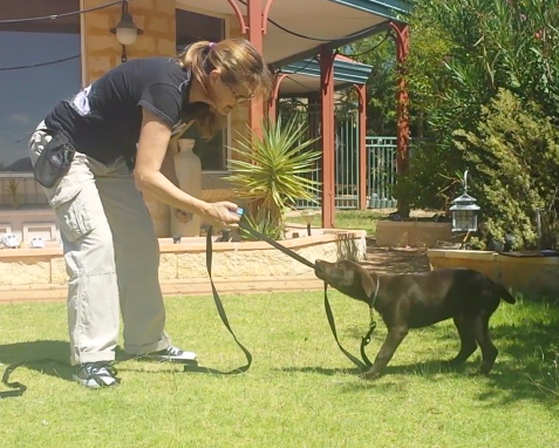Reasons may include that:
* it’s reinforcing. Puppies explore with their mouths and many leads seems to feel good to chew. The attention a dog gets when they start chewing may also be reinforcing: the dog gets looked at, spoken too, touched to the point that trying to retrieve the lead from his mouth becomes a super-fun game of tug. If it wasn’t reinforcing, a dog wouldn’t continue to do it.
* it’s due to frustration. It may be a displacement or replacement behaviour. If a dog cannot access something they want, they may turn on the lead which is restricting them and chew in response.
* it’s a response to something a dog wishes to escape or avoid. They may desperately chew on the lead that is preventing escape.
I choose to introduce a behaviour that replaces the biting and pays off more. If the reason is due to frustration, I provide an alternative behaviour in conjunction with teaching the dog some impulse control in an environment in which he can succeed. It is not effective or efficient to attempt teaching a dog who is already frustrated. For fearful dogs I avoid putting them in the situations that trigger the escape/avoidance response whilst working on helping them overcome the fears in a controlled and safe environment.
My ethos is that training should enhance the relationship between the dog and guardian. For this reason, I avoid punishment-based techniques to stop the behaviour after it has already occurred. Punishment has side effects. The type and intensity of the fallout becomes evident only after the damage has been done. Further, it is generally much harder to reverse than it is to cause. I value the human-dog relationship too much to risk gambling with such consequences.
I label many training tasks as games. I do this deliberately because games should be;
a) mutually enjoyable,
b) a vehicle for building positive relationships, and
c) a fun way to learn practical skills.
When has playing games been boring or time wasted with friends? Of course, each individual must enjoy the actual game chosen. It's not truly relationship building if only one party is enjoying it. So it should be with our dogs. I add another proviso; games with our dogs should be win-win. There is no loser when teaching your dog in this way. You will choose to teach your dog skills which will be beneficial and your dog will be reinforced with something he values and enjoys. A relationship of trust is another wonderful outcome.
The “Don’t Chew The Lead Game” and “Drop The Slack Lead Game” are two of my favourite ways to prevent lead chewing and tugging. The emphasis is on prevention by setting the dog up for successfully choosing an alternative behaviour before he bites. If he gets distracted and starts chewing, the “Drop The Lead Game” then gives an alternative behaviour rather than continuing to chew or tug. No force is required and no raised voice.
Here’s some handy extra hints:
* If your dog starts chewing as soon as the lead is clipped on (or before), start the game earlier. Simply show your dog the lead and reinforce for the behaviour of staying still, sitting or just looking at the lead rather than jumping up to bite it. Only clip the lead on when you know your dog won’t bite it. If your dog won't give you an alternative behaviour when you are showing the lead, problem solve why this might be.
Is he looking for one second before jumping? Anticipate this and work on your timing. Click that look and get the treat to his mouth before he can leave the ground.
Is the lead too close to him? Hold it higher.
Does movement make him jump? Hold the lead still.
Is he grabbing the end of a dangling lead? Fold the lead up and show him, so there are no dangly bits.
* Deliver food directly into your dog’s mouth or onto the ground as this will prevent your dog jumping up. This helps prevent jumping to get the lead as well.
* Avoid letting your dog chew the lead at other times. Avoid putting him in situations where he does chew to get quicker and more robust results.
Here’s a video showing how I approached teaching Yoda the kelpie and Abby the labrador not to chew and tug the lead.
I hope this helps you in devising a plan for preventing this behaviour. Most of all, I hope this increases the fun-factor for you and your dog.


 RSS Feed
RSS Feed